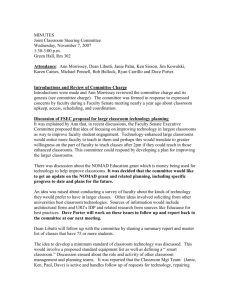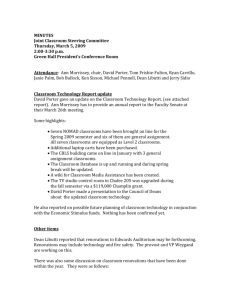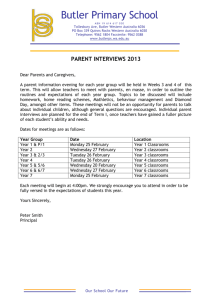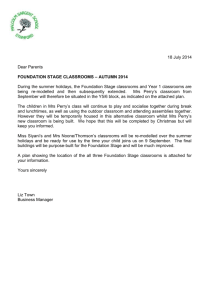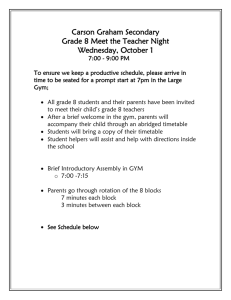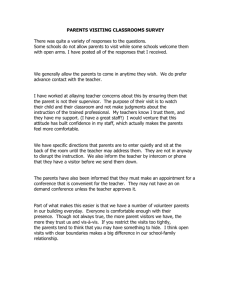Meeting Notes Joint Classroom Steering Committee March 1, 2010
advertisement
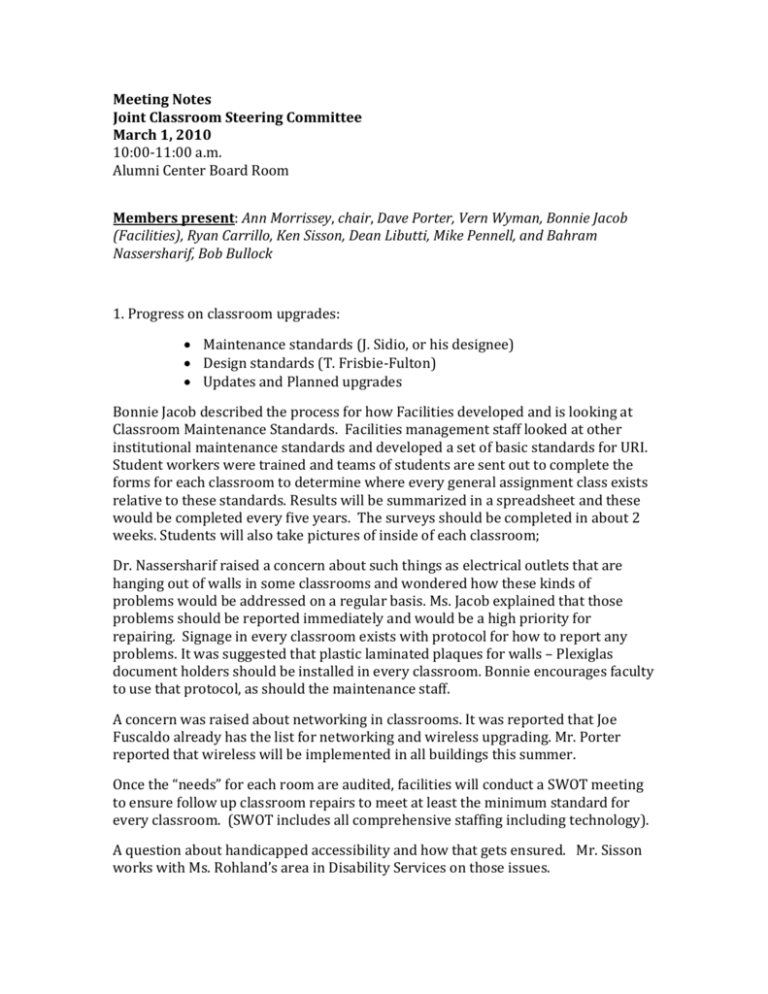
Meeting Notes Joint Classroom Steering Committee March 1, 2010 10:00-11:00 a.m. Alumni Center Board Room Members present: Ann Morrissey, chair, Dave Porter, Vern Wyman, Bonnie Jacob (Facilities), Ryan Carrillo, Ken Sisson, Dean Libutti, Mike Pennell, and Bahram Nassersharif, Bob Bullock 1. Progress on classroom upgrades: Maintenance standards (J. Sidio, or his designee) Design standards (T. Frisbie-Fulton) Updates and Planned upgrades Bonnie Jacob described the process for how Facilities developed and is looking at Classroom Maintenance Standards. Facilities management staff looked at other institutional maintenance standards and developed a set of basic standards for URI. Student workers were trained and teams of students are sent out to complete the forms for each classroom to determine where every general assignment class exists relative to these standards. Results will be summarized in a spreadsheet and these would be completed every five years. The surveys should be completed in about 2 weeks. Students will also take pictures of inside of each classroom; Dr. Nassersharif raised a concern about such things as electrical outlets that are hanging out of walls in some classrooms and wondered how these kinds of problems would be addressed on a regular basis. Ms. Jacob explained that those problems should be reported immediately and would be a high priority for repairing. Signage in every classroom exists with protocol for how to report any problems. It was suggested that plastic laminated plaques for walls – Plexiglas document holders should be installed in every classroom. Bonnie encourages faculty to use that protocol, as should the maintenance staff. A concern was raised about networking in classrooms. It was reported that Joe Fuscaldo already has the list for networking and wireless upgrading. Mr. Porter reported that wireless will be implemented in all buildings this summer. Once the “needs” for each room are audited, facilities will conduct a SWOT meeting to ensure follow up classroom repairs to meet at least the minimum standard for every classroom. (SWOT includes all comprehensive staffing including technology). A question about handicapped accessibility and how that gets ensured. Mr. Sisson works with Ms. Rohland’s area in Disability Services on those issues. An issue was raised about the need to review classrooms in daylight with regard to each room’s capacity for using audiovisual with the proper window screening to ensure visibility. This should be a summer – 2010 project for Facilities if they are unable to incorporate presently in their classroom reviews during March. A concern was raised about the planned five-year inventorying timeframe. Committee members believed it is necessary to conduct more frequent inventorying in order to ensure goals of maintaining classrooms standards. Suggestions were made to Facilities Services that custodians could be asked to conduct a one-time yearly surveying of all their assigned classrooms. Another suggestion for the ongoing completion of classroom maintenance would be to coordinate this through Mary Fetherston’s group. Ms. Jacob will convey these suggestions to Mr. Sidio for follow up and report back to the committee. The ultimate goal for these classroom surveys is to merge and integrate these databases between Joe Fuscaldo and technology areas Classroom Media Assistance. Questions were raised about the funding and prioritizing process for classroom repairs. It was reported that: Facilities has the ability to make minor repairs within their budget. They also have out-source capability for repair. The asset protection is one fund source for major project repairs; ($4.4m in total). Those involve design and bid process; more time consuming. It was conveyed that the SWOT team decides as to how and what will be addressed and when. It was noted that there is a need for faculty to provide feedback about the classroom condition and need for upgrades and repairs in the process of the SWOT. Mr. Carrillo assured the committee that this element would be incorporated into the SWOT process. JCSC would like to have Facilities report back to the committee on the results of the maintenance surveying and the repairs that were addressed as well as any that may not have been addressed. This would be incorporated into the JCSC annual report due April 1st. Discussion noted that much work was to be accomplished over the summer for repairs and furnishings. The committee agreed that the campus community should be informed by Facilities, Capital Planning and the Technology area about all the work done relative to improving classrooms. This should be done through an integrated communication that could go out through the campus communications and media area, including a link to any other related information. Ryan Carrillo reported that classroom furnishing upgrades are planned for Washburn and Crawford – 7 classrooms total. A challenge with new furnishings has been that they sometimes reduce capacity. The goal would be for new furnishings to allow for flexibility in pedagogy, but not negatively impact room capacity. Again, the issue of faculty input into the process of classroom furnishing choices was expressed. Ryan assured the committee that the staff that chooses furnishings would consult with group of faculty and maintenance. Funding this year for new furnishings in Washburn and Crawford will come from one-time vacancy from the division of Administration. 2. Technology classroom upgrades and planning – updates (D. Porter) Mr. Porter reported that 15 classrooms total to be done this summer; 6 are NOMAD; some in Providence. Presently, it is frustrating that all improvements are being dictated by an available funding source, typically a grant source (like NOMAD). The CMT (Classroom Management Team) is the other group that identifies classrooms – but funding is severely limited. There is no classroom technology-funding source for planning, maintenance, and improvements and upgrades. This needs to be addressed with fees or other funding sources. Mr. Porter relayed that technology fees went into the university’s base budget, which then got shrunk with State/university budget cuts. Mr. Porter related other challenges in improving technology in classrooms. In particular, the State system for bid process and the long time frames and complicated protocol that hold up work. Some of the challenge has been addressed with extended use of blanket POs, however, a staffing shortage exists to install and maintain the expanded technology. Further, we need to formalize a process to test and select classroom technology, which may involve faculty from School of Education to get feedback from a pedagogical technology. This is ongoing. 3. Follow up: Asset Protection & other funding (V. Wyman) Mr. Wyman reported on the end of investment in the energy performance contract whereby lighting has been addressed – a share of improvements that pay for themselves – HVAC and lighting combined have been able to drive a significant classroom investment – higher quality of light and lower wattage; more uniform bulbs. Design work has also been conducted on two Morrill Hall labs – as a highest priority in conjunction with organic chemistry instruction at the cost of $750k into two labs this summer and through fall. NOMAD funds – four rooms in Chafee this summer, four rooms in Quinn this past fall, Chafee psychology department and HVAC in federal support money planned to upgrade. White Hall classrooms have been enhanced through Federal and supplemental funding for furnishings and AV. There are several NOMAD-planned projects this summer and the Morrill labs and library learning commons are the priority projects; Washburn work will include just furnishings (not painting or other enhancements) from vacancy funding that the Administration is dedicating. Mr. Wyman reported they are now in the process of reviewing the capital planning priorities and items. The meeting adjourned at 11:00 a.m.
